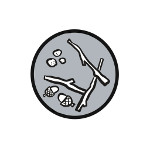Walk through the Centennial Parklands, discover its trees and the animals that call them home.
Explore the remarkable world of trees and the creatures that live at Lachlan Swamp. These trees thrive in a wetland environment where there is a constant supply of freshwater from an underground aquifer. You may see or smell this spring water. The smell can be pungent, like ‘rotten eggs’ from the sulphuric compounds. The colour of the water looks orange from naturally occurring iron and bacteria.
The trees in this swamp provide important habitat for the Grey-headed Flying-fox, a threatened species. These creatures provide a critical function in the ecosystem - to pollinate and distribute plant seeds. Flying-foxes help provide humans and other animals with fruit trees and fruit to eat.
The animals that inhabit these forests help to the trees to survive by providing nutrients in the soil and dispersing seeds. In turn, the paperbark forest of Lachlan Wetland provides habitat for the Flying-foxes to live in.

Please be aware that touching natural parts might cause allergic reactions.
Allow approximately 1 hour
1. Swamp Casuarina
Scientific name: Casuarina glauca
A native tree to the area, it is not a pine tree but it looks similar to one.
 Fun Fact
Fun Fact
These trees don’t like other types of plants (species) growing underneath them. They emit a chemical in their leaves that stop other plants growing in soil under their needles (this is called allelopathy).
 Activity
Activity
Tawny Frogmouths are nocturnal birds, but not owls. A family of Tawny Frogmouths often live in these trees. They sit very still on tree branches to camouflage themselves. Can you see any Tawny Frogmouths?
2. Port Jackson Fig
Scientific name: Ficus rubiginosa
Location: Find a dark green leaved wall created by an old and large fig tree. Enter through the foliage. This tree is around 120 years old.
 Fun Fact
Fun Fact
All native figs are edible but they may not taste very nice! Fig flowers grow on the inside of fruit, rather than the outside, giving the fig its unique texture. When you eat a fig, you are eating tiny flowers, or florets.
 Activity
Activity
Can you find a fig fruit on the ground? Open the fruit up and what do you notice?
Now we enter into the Swamp. Keep your eyes peeled for the following plants or animals and do the activities.
3. Bats Wing Fern
Scientific name: Histiopteris incisa
Location: Look down low to find a soft light green coloured fern. Look closely at its fronds.
 Fun Fact
Fun Fact
Ferns are some of the oldest plants in the world, being around since before and during the dinosaur age. Ferns do not have flowers and seeds, instead they have spores. Can you find any spores on the back of the frond? They look like brown coloured dots.
 Activity
Activity
Can you find the shape of a bats wing in the fern frond? Use your paper and pencil to draw this bats wing.
Can you add the body of a bat now to these wings? The two lowermost leaf lobes on the frond, called pinnae, look like a bat’s wing.
4. Grey-headed Flying-Fox
Scientific name: Pteropus poliocephalus
Flying-foxes are important pollinators of fruit trees and a ‘keystone’ species in the ecosystem: without them, the ecosystem would collapse!
Flying-foxes are nocturnal and fly out on dusk to find fruit to eat. Be quiet when you are in their habitat. Can you hear them? What are they saying to each other? They are noisy sleepers! Flying-foxes can squabble each other for territory and also warning each other of a possible threat.
 Fun Fact
Fun Fact
There is a big old paperbark tree in the swamp that is a special nursery tree for baby Flying-foxes. Baby Flying-foxes are carried by their mother for the first three weeks. As the baby grows older and heavier, the mother needs to leave them behind in a special ‘creche’ in the maternity camp, in order to fly out and find food.
 Activity
Activity
How many bats can you count in the canopy?
5. Broad-leaved Paperbark
Scientific name: Melaleuca quinquenervia
Find more paperbark trees as you enter Lachlan Wetland. These are medicine trees.
 Fun Fact
Fun Fact
The oil released from paperbark (Melaleuca) leaves by crushing them, is a medicine with antibacterial properties. Tree-tree oil is sold commercially but is actually Melaleuca oil. Aboriginal people made a tea from the young leaves to help colds and headaches, and this is how ‘tea-tree’ got its name.
 Activity
Activity
Find a paperbark leaf on the ground. Now crush it and smell it. What does it remind you of? You may recognize this smell as tea-tree oil.
Now we enter the board walk into the Swamp. Keep your eyes peeled for the following plants or animals and do the activities.
6. Mat Rush
Scientific name: Lomandra longifolia
A large grass-like plant with long strapping leaves. This is a native plant that is often used today in roadside plantings and landscape gardening.
 Fun Fact
Fun Fact
Aboriginal people had many uses of this plant. It is a food source, water source, medicine and weaving material! Aboriginal women harvested the seeds and ground them to make a flour to bake bread. The long leaves were also harvested by women, dried and then used for weaving baskets.
 Activity
Activity
The tips of the leaves are spikey – be careful. Can you find a smaller young shoot towards the middle of the plant that comes out easily when pulled? The white part of the young shoot is edible and source of carbohydrate and water.
Make sure you turn right now and enter into the depth of the Swamp
7. Sydney Golden Wattle
Scientific name: Acacia longifolia
Can you find a burst of yellow sunshine in the forest?
 Activity
Activity
Use your possum paws to gently feel the flowers and leaves. How do they feel? Do the flowers have a smell? The leaves are tough and leathery to reduce water loss.
 Fun Fact
Fun Fact
When these wattles bloom in winter, it was a seasonal sign for Aboriginal people that the whales were beginning their migration north.
8. Sandpaper Fig
Scientific name: Ficus coronate
Location: As you walk along the boardwalk, look eye height on your left for an understory plant with dark green rough looking leaves. This tree will one day become a canopy species.
 Fun Fact
Fun Fact
How do we know what the Flying-foxes have been eating? Look closely at the different plants growing in the understory. The Flying-foxes are planting trees with seeds from their poo.
Sandpaper figs are sweet and a favourite food of the Flying-fox, as well as a tasty bush tucker. The sandpaper fig gets its name from the rough sandpaper-like leaves and Aboriginal people used the leaves to smooth and polish tools
 Activity
Activity
Feel the leaf between your fingers. How does it feel? Does it remind you of something?
Congratulations – you made it out of the Swamp.
Have a look at the beautiful tree next to the white bridge.
9. Swamp Mahogany
Scientific name: Eucalyptus robusta
Safari Quest: Continue to walk down toward the white bridge. As you cross the bridge, look in Lily Pond for freshwater eels, turtles, ducks and water birds.
 Fun Fact
Fun Fact
Flying-fox camps are becoming increasingly urban, possibly because they are losing habitat elsewhere. We still don’t know enough about Flying-foxes in the urban environment.
This is where you can help through citizen science! Download the CAUL app and start recording your observations today. The data is collected by University of Melbourne and used to help researchers balance conservation and community concerns.
 Activity
Activity
Place paper onto the bark and take a bark rubbing by using the side or blunt edge of your pencil or crayon to gently rub over the paper. How does the bark feel? Is there anything else nearby that would make a good rubbing? You could try a leaf rubbing.
And for the last station, stand on the bridge and check out the stream underneath. Can you see our...
10. Long-finned eel
Scientific name: Anguilla reinhardtii
Location: Standing on the white bridge looking in the water underneath
You will see ducks and water birds in the freshwater ponds. Look closely and you might find turtles and freshwater eels. Water in Lily Pond comes from the natural underground springs in Lachlan Swamp.
 Fun Fact
Fun Fact
Freshwater eels live their adult lives (up to sixty years) in the ponds of Centennial Park. To breed, these eels go on an incredible journey through drains and over roads, down to Botany Bay, where they enter salt water and migrate towards New Caledonia where they lay their eggs deep in the ocean.
Baby eels find their way back into the ponds of Centennial Park and other freshwater sources in eastern Australia and New Zealand.
 Activity
Activity
How many different water creatures can you find? Are there tiny bugs in the pond that you can also find?
 Additonal Activity
Additonal Activity
Download the CAUL Urban Wildlife app to help monitor native wildlife in Australian cities. You can record sightings of Flying-foxes, view all of your previous records, and see a map of where other citizen scientists have recorded Flying-foxes in your area.
Go to https://nespurban.edu.au/platforms/caul-urban-wildlife-app/flying-foxes/
And follow the instructions to download the app, a quick training session, and how to start recording sightings.